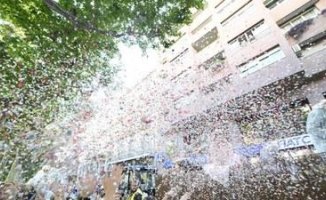Some of the books that we will browse today in bookstores and at the Sant Jordi stalls we will have also seen on a television or movie screen. Or we will see them in the future. "The marriage between literature and the audiovisual is very long-lived and has brought great joy," says Verónica Fernández, director of fiction for Netflix in Spain, who recalls the examples of La Regenta or Fortunata y Jacinta on RTVE from decades ago. “Years ago, it was only thought of making adaptations of old and period novels, with large productions, but today the field has been opened to recently published novels and with closer stories,” she points out.
"It's a precious opportunity to give a new dimension to books and for people who don't read or who think you don't fit their tastes to discover you," says Javier Castillo, author of the novel La chica de nieve, adapted by Netflix and which has become one of the platform's global phenomena: it reached the global top 1 of the most watched non-English-language series in its opening week and was in the Top 10 of 77 countries for several weeks, including number 1 in countries like Spain, France, Sweden or Belgium among many others.
Adapting a literary work to audiovisual codes and language is a different challenge in each case. In La hija de nieve, for example, "we split the figure of the policeman into two characters to be able to have two people talking and not an internal monologue," says Fernández. All the changes forced by the audiovisual language have a red line: preserving the spirit, the main plots and "also the emotions you feel when you are reading the novel, with its emotional ups and downs and its script twists," explains Castillo. "It does not have to be replicated scene by scene in the adaptation, images other than the novel can be used."
If the adaptation is for a movie or a series, the challenge is also different. It is not the same to have 90 minutes or six episodes out of 50. In a movie, more plots and characters tend to disappear. "In addition, I believe that the structure of a series is more similar to that of a novel than a movie," says Fernández, while Castillo points out that in novels like his, "which have many twists," the division into episodes, with cliffhanger at the end of each one included. Many authors are already infected by cinematographic and audiovisual language and "many times, when you read a novel you are already seeing it too," says Fernández.
To what extent are the authors involved in the script process? “I really enjoy the writing process and how to continue giving life to what I do. When Netflix opened this door, I wanted to participate or at least give my opinion. And in a natural way I participated more and more in the script process because novels and scripts, with different dynamics, have the same objective, which is to excite people so that they want to continue reading or continue watching”, answers Castillo.
Fernández praises Castillo for letting things go and respecting the work of the scriptwriters and the production company. "He has been generous enough not to hold on to the novel as if it had been written in stone and understand that it was going to become something else." Not all writers have the same attitude or want to be involved in the same way. Fernández recommends to some authors "that it is better not to get involved because they will not understand the changes and they will suffer a lot."
According to a study by the DAMA entity, between 2015 and 2019, 24.7% of the films and 25.3% of the series analyzed were based on novels. “It is an important figure and I think that in recent years it has surely risen”, assesses Fernández. "Netflix's philosophy is to go where the best stories are and if they are in novels, then we go for them, but we can also go to the theater, as happened with Smiley," continues Fernández, who explains that there is a content team on the platform “who reads a lot and who is in contact with publishers and authors”.
Television adaptations can also cause a 'literary renaissance', that is, novels benefit from the success of a series. "Adaptation is an incredible window, but not only in Spain but throughout the world," says Castillo and comments on his own case. The snow girl became, a week after the premiere of the series, in number one in the paperback edition, and its second part, The game of the soul, in number two.
And outside of Spain, the rights to many countries were sold "but in some of them, such as the United Kingdom, Germany or the United States, they were always on the edge of hiring my novels but they never made up their minds and as a result of the series the balance tipped over" . The writer sees it as a gift that makes his work visible because, "although we try to make the essence of the series and the novel the same, at the same time it is different, which means that people are not reluctant to read the book after reading it." watch the series."
Fernández points to other cases of literary renaissance such as El inocento, by Harlan Coben, which after premiering the adaptation on Netflix was reissued in Spain 15 years after its publication. Or like Queen's Gambit, The Bridgertons and even Lupin, which suddenly caused a novel from the early 20th century to be reissued. "Our goal is not to sell books but to please our audience, but it seems like a precious side effect," says Fernández. “It is impressive that Lupine now returns to occupy bookstore windows in France when it was a disappeared book, one of those that were singing in small sections”, concludes Castillo.













